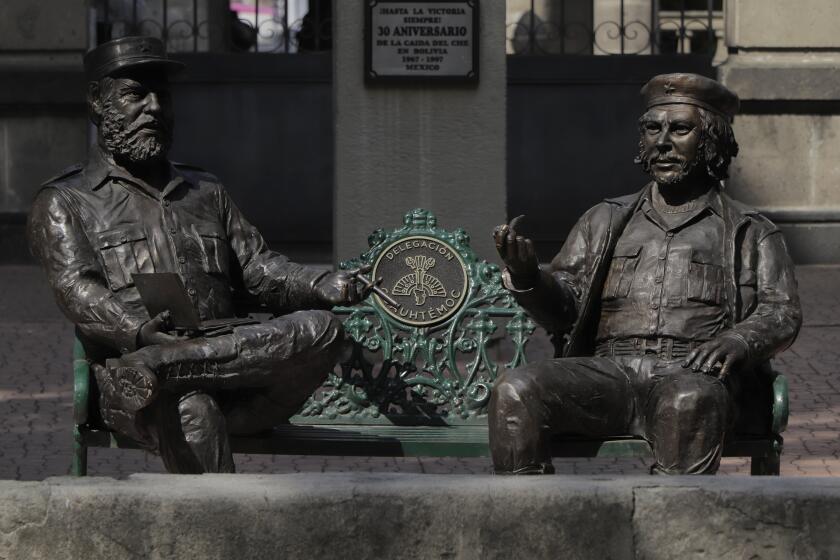Goodbye, Fidel.
Hasta la vista, Che.
Denunciations and accolades greeted the abrupt removal this month of a controversial monument in the Mexican capital commemorating the two revolutionaries, Fidel Castro and Ernesto “Che” Guevara.
The monument, a pair of bronze, life-sized sculptures of Castro and Guevara chilling on a bench, recalls a consequential moment in both Mexican and Cuban history — the pair’s first meeting, which took place in an apartment in Mexico City in June or July 1955, according to historians.
At the time, both were twentysomething militants in the formative stages of their transformation into leftist icons who would inspire a global generation of revolutionaries and activists.
Fidel Castro makes a televised address to the Cuban people in 1960, one year after deposing Fulgencio Batista. (Associated Press)
A leftist Mexico City government installed the monument in 2017 in a small park in the capital’s Colonia Tabacalera neighborhood, not far from where the storied duo first met in a Cold War encounter that has taken on near-mythical dimensions among many on the left.
In the two sculptures, both men stare straight ahead and are decked out in light combat garb — Guevara in his trademark beret (a look immortalized on T-shirts across the globe) and Castro sporting a fighter’s cap. His legs crossed, Castro grasps a cigar in his left hand, and a book on his right. Guevara’s right hand secures a pipe.
The sculpture has long sparked polemics: While adherents of the left generally applauded it, and some visitors would leave flowers, critics assailed the artwork as a tasteless shrine to a bloody communist dictatorship.
César Huerta, left-wing journalist, on the statues’ removal
Spearheading its removal Wednesday was Alessandra Rojo de la Vega, conservative borough president of the capital’s central Cuauhtémoc district, where the bench (known as Encuentro or Encounter) was situated.
Her decision, Rojo de la Vega initially explained on social media, was based on legality — not politics. She said there wasn’t “one single paper” authorizing the monument’s installation. Its removal, she added, would allow park denizens to stroll in “liberty and security.”
Read more: Case of ‘El Chapo’ son cooperating with U.S. prosecutors roils Mexico
She posted images of city workers prying out the two figures from the bench and the bronzed Castro and Guevara being ignominiously hauled away in a bulldozer.
But the borough president later pivoted to a more ideological rationale.
“This city cannot … promote or provide refuge for figures who injured human dignity, be it in Mexico or the rest of the world” Rojo de la Vega told Radio Formula.
As to the fate of the dual bronzes, she said that officials may consider a sale, using the proceeds — likely from lefty purchasers enthralled with the Cuban uprising — for park upkeep.
Read more: Many Mexican immigrants swept up in L.A. raids are deeply rooted in U.S.
“If we auction them off, it will mark a first — the communists will use their money, not someone else’s,” Rojo de la Vega said. “If they love them so much, they can put them in their garden, or their patio.”
Not pleased was Mexico’s leftist president, Claudia Sheinbaum, who said she would speak to the Mexico City mayor — a political ally — about placing the monument elsewhere.
The question isn’t whether one embraces or rejects the views of the two protagonists, Sheinbaum argued to reporters on Thursday. The Castro-Che encounter, the president said, recalled “a historic moment” that unfolded in Mexico and merited a display of memory.
The contretemps here echoes spats in the United States about monuments glorifying Confederate generals: Critics decry the displays as exalting traitors and white supremacists, while others argue that the statues just reflect history.
‘An assassin with good press’
José Luis Trueba Lara, radio commentator, on Ernesto ‘Che’ Guevara
In the case of the Castro and Guevara likenesses, Sheinbaum suggested that their removal was partisan payback for her own signature monument-canceling moment — the banishment of one of Mexico’s most illustrious landmarks, a virtual symbol of the city.
In her former post, as mayor of Mexico City, Sheinbaum ordered the removal of a soaring bronze of Christopher Columbus, which, for more than a century, graced a pedestal in the capital’s elegant Paseo de la Reforma. The stylized tableau depicted Columbus as a noble conqueror: one hand raised to the horizon, the other lifting a veil from a globe.
For years, Indigenous activists and others staged protests at the statue, labeling Columbus and other conquistadores as perpetrators of genocide. In 2020, Sheinbaum finally ordered that the Columbus monument be taken down for renovations; it was never returned to its lofty perch.
Its ejection enraged both Columbus’ admirers and others who viewed the monument as an integral marker of the Mexican capital. They accuse Sheinbaum of bowing to political correctness.
The traffic circle where Columbus long lent his presence has now been renamed the Women Who Fight roundabout, a rallying point for Indigenous, feminist and other protesters hoisting handwritten placards.
The grandiose Columbus figure, meantime, remains out of public sight in museum storage.
The Castro-Guevara bench, situated in an easy-to-miss park, didn’t compare in size or significance to the towering Columbus of the stylish Paseo de la Reforma. But its removal lit up social media, rekindling historic enmities.
“An intent to erase the symbols of battle, of resistance, of Mexican-Cuban humanity,” César Huerta, a left-wing journalist, wrote on X, blasting the action as “ideological censorship.”
Read more: How ‘El Diablo,’ a corrupt Mexican lawman, helped create a narco-state
A radio commentator, José Luis Trueba Lara, bid good riddance, calling Guevara “an assassin with good press” and Castro a “bloodcurdling dictator.”
Carlos Bravo Regidor, a columnist, berated the left for being more concerned “about the retirement of some miserable statues of Fidel and el Che than for the misery suffered by those who live beneath the yoke of the Cuban dictatorship.”
At the time of his 1955 encounter with Guevara, Castro, then 28, was not long out of a Cuban prison for an insurgent attack against the U.S.-backed Cuban dictatorship of Fulgencio Batista.
Guevara, one year younger, was a physician from a middle-class Buenos Aires’ upbringing brimming with revolutionary fervor — and a vision of a pan-Latin American socialist union, free of U.S. “imperialism.” The two young men immediately hit if off, historians say, embarking on a lifelong friendship and collaboration in the revolutionary project.
Both would be among 82 fighters aboard the yacht Granma that, in November 1956, set sail for Cuba from Mexico’s Gulf coast. Their voyage, and subsequent guerrilla campaign, would culminate in 1959 in a historic overthrow of Batista and the imposition of a communist government in Havana.
Fidel and el Che are long gone, and the book on the Cold War officially closed more than a quarter-century ago. But, as the fiery debate here about an unassuming bench statue illustrates, the ideological fault lines of the Cold War are far from completely obscured, at least not in Latin America.
Special correspondent Cecilia Sánchez Vidal contributed.
This story originally appeared in Los Angeles Times.

